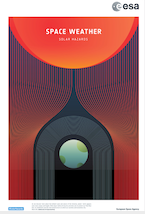Speaker
Description
Radio emissions in the MF and HF bands (typically from 0.1 to 30 MHz) provide an important diagnostic of solar activity as radio bursts are generated by energetic electrons in the vicinity of interplanetary shocks that are associated with geoeffective coronal mass ejections. While such electromagnetic emissions are usually detected by means of electric field antennas, their magnetic component can also be measured with magnetic loop antennas. The latter consist of a small circular loop with an air core; the diameter is typically 20 to 30 cm.
Two major advantages of such magnetic sensors are their compact size and simplicity, and their higher sensitivity for detecting radio emissions relative to the galactic noise level (as compared to electric field antennas that are typically 10 m long). Such loop antennas have already flown on the POLAR spacecraft and on the CHARM sounding rocket. Here, we discuss the prospects for tailoring such sensors to the needs for monitoring the space environment.

